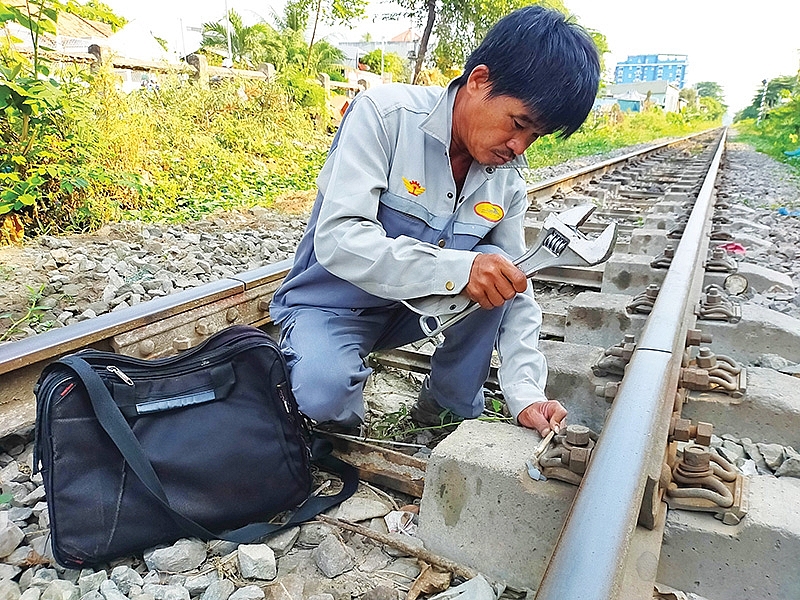Vietnam Railways bets on upgrades
 |
| Vietnam Railways will use AI technology to maximise the efficiency of physical infrastructure, Photo Le Toan |
Vietnam Railways (VNR) has just begun to apply freight management system software on the national railway network after some trials. It is the result of co-operation between VNR and FPT Information System Co., Ltd., which is assisting the former in overhauling its traditional freight governance. The software enables the giant to deploy network administration in management and operation of locomotives and railroad cars along with freight management. With the new deployment, the traditional recording and exchanging information by phone is replaced with data entry and information exchange on the system.
“This system can digitalise the entire transportation process, including standardising reporting and statistical forms, helping administrators manage more efficiently and therefore saving on cost and reducing manual works,” said Phan Quoc Anh, deputy general of VNR.
This is one of several applications that the railway industry has deployed in recent times. Previously, VNR has also co-operated with e-wallet startup MoMo to launch a new e-service that allows mobile phone users to purchase train tickets online through an app.
Like most industries, digital transformation is making huge impacts on rail transport, motivating it to make positive changes. The traditional measurements for rail transport performance requirements remain, but there are added advantages in the application of digital technologies.
For railways, the main impact of digitalisation is on the model of operation. Technologies like AI, big data, cloud computing, and autonomous driving will impact the industry. These technologies are expected to create a new environment in which rail operators will need to be more agile, act more quickly, and change continuously in order to succeed in their mission amid stiffening competitions from rivals.
Given all these factors, transformation is inevitable and not just an option. VNR is aware of this, with council members recently approving a scheme on technology application for this decade, focusing on business governance along with safety within management, mechanics, transport, and infrastructure.
Specifically, for business governance, VNR will gradually strengthen AI-backed analysis systems, establish a sci-tech research and development centre as well as IT centres, and also upskill manpower. In railway safety, it aims to digitalise all data related to traffic safety, management, training, communications, analysis, accident warnings, and risk management.
Regarding mechanics, VNR will invest in automation of manufacturing factories so as to develop into two modern manufacturing sites to assembly locomotives and railroad cars, and produce spare parts with localisation rate increasing to 50 per cent for locomotives and over 70 per cent for railroad cars. In terms of transport, the giant will increase connection with other means of transport such as road, sea, and air while ensuring rising application of technologies to ensure safety and increase service quality, administration, operation, and capacity.
In spite of the moves, digital transformation in the railway sector faces a challenge in technology application due to underdeveloped infrastructure. Unlike other sectors, railways infrastructure has been downgraded in recent times.
To deal with the problem, the Ministry of Transport in mid-May started a long-awaited VND7 trillion ($304.35 million) package to upgrade the North-South railway network. However, it will take the railway industry about two years to finish, meaning that the technology application for infrastructure cannot proceed right away. “The upgrading will be completed in late 2021. The railway industry will face difficulties to keep the frequency and capacity of train operation during the period,” VNR chairman Vu Anh Minh told VIR. “Even completed, technology application remains a hard task because of unsynchronous and not-modern-enough infrastructure.”
According to the national railway development strategy, the industry is estimated to require VND110 trillion ($4.78 billion) by 2030 to revamp the existing network. With the limited state budget, calling for private investment is a priority. VNR is betting on its new restructuring plan which is set to be approved by the government in the near future, in which it plans to dump its monopoly in cargo transport by divesting stake in cargo transport. Moreover, it also hopes that the master plan on management, use, and operation of national railway infrastructure in line with 2018’s Decree No. 46/2018/ND-CP dated March 14, 2018 on management, use and operation of national railway infrastructure will be soon approved. This would enable the group to take the initiative with its investment plans and to be looked upon more favourably when calling for private investment in upgrading stations and logistics facilities, as well as developing stations that enjoy commercial advantages.
Vietnam’s railway industry is attracting interest among international investors from the likes of Japan, France, China, Germany, and the United States, who are all seeking business opportunities in anticipation of huge future demands to upgrade and develop the system.
What the stars mean:
★ Poor ★ ★ Promising ★★★ Good ★★★★ Very good ★★★★★ Exceptional
Themes: Digital Transformation
Related Contents
Latest News
More News
- Businesses ramp up production as year-end orders surge (December 30, 2025 | 10:05)
- Vietjet chairwoman awarded Labour Hero title (December 29, 2025 | 13:06)
- How to unlock ESG value through green innovation (December 29, 2025 | 10:03)
- AI reshapes media and advertising industry (December 29, 2025 | 08:33)
- FPT and GELEX sign deal to develop blockchain tech for global markets (December 29, 2025 | 08:29)
- Vietnam’s GDP forecast to grow by 9 per cent in 2026 (December 29, 2025 | 08:29)
- Women entrepreneurs are key to Vietnam’s economic growth (December 29, 2025 | 08:00)
- Vietnam's top 500 value-creating enterprises announced (December 27, 2025 | 08:00)
- The PAN Group shaping a better future with ESG strategy (December 26, 2025 | 09:00)
- Masan Consumer officially lists on HSX, marking the next phase of value creation (December 25, 2025 | 13:20)

 Tag:
Tag:





















 Mobile Version
Mobile Version